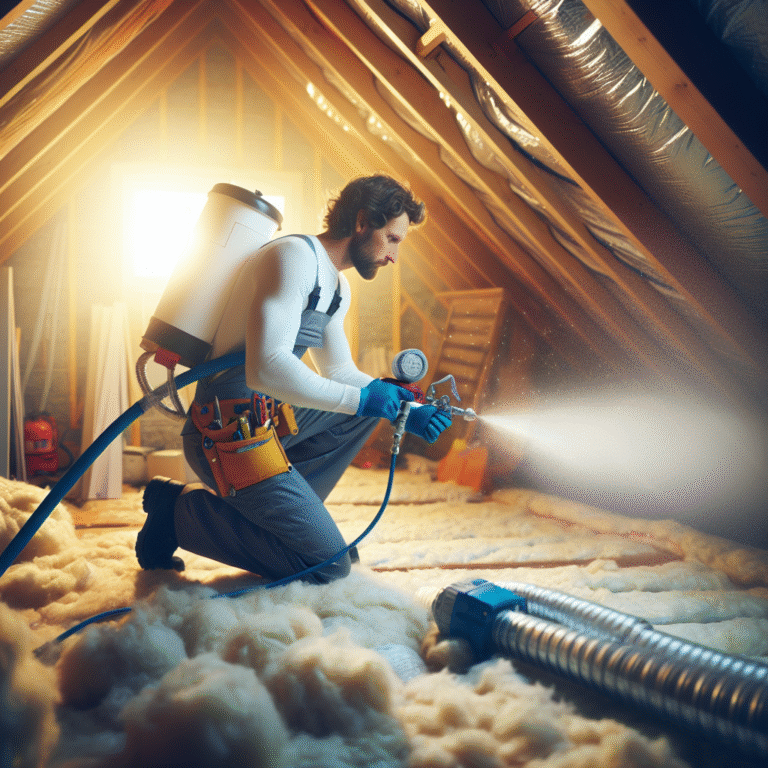-
Table of Contents
- Introduction
- Benefits of Blown-In Attic Insulation for Energy-Saving: Discuss the various ways in which blown-in attic insulation can help save energy, such as reducing heat loss, preventing air leaks, and improving overall energy efficiency in a home
- The Process of Blown-In Attic Insulation Services: Explain the steps involved in the installation of blown-in attic insulation, including preparation, equipment used, and the actual process of blowing in the insulation material. This can help potential customers understand what to expect when hiring a professional for this service
- Choosing the Right Blown-In Attic Insulation for Your Home: Discuss the different types of blown-in insulation materials available, such as fiberglass, cellulose, and mineral wool, and their respective benefits and drawbacks. This can help homeowners make an informed decision when selecting the best insulation for their specific needs
- Q&A
- Conclusion
“Efficiently insulating your attic for a comfortable and energy-efficient home.”
“Upgrade your home’s energy efficiency with our professional Blown-In Attic Insulation Services. Contact us today at TexasInsulationSolution.com to schedule a consultation and start saving on your energy bills!”
Introduction
Blown-in attic insulation services are a popular and effective way to improve the energy efficiency and comfort of a home. This type of insulation involves using a machine to blow loose insulation material, such as fiberglass or cellulose, into the attic space. This method allows for a more thorough and even coverage, filling in any gaps or hard-to-reach areas. Blown-in attic insulation can help reduce energy costs, prevent air leaks, and improve overall indoor comfort. It is a cost-effective and environmentally friendly solution for homeowners looking to improve the insulation in their attics. In this article, we will explore the benefits and process of Blown-in attic insulation services.
Benefits of Blown-In Attic Insulation for Energy-Saving: Discuss the various ways in which blown-in attic insulation can help save energy, such as reducing heat loss, preventing air leaks, and improving overall energy efficiency in a home
Blown-in attic insulation is a popular and effective method for improving energy efficiency in homes. It involves using loose insulation material, such as fiberglass or cellulose, to fill the spaces in an attic. This creates a barrier that helps to reduce heat loss, prevent air leaks, and ultimately save energy. In this article, we will discuss the various benefits of Blown-in attic insulation for energy-saving.
One of the main benefits of Blown-in attic insulation is its ability to reduce heat loss. Heat naturally rises, and without proper insulation, it can easily escape through the attic. This can result in higher energy bills as the heating system works harder to maintain a comfortable temperature. However, with blown-in insulation, the heat is trapped within the attic, keeping it from escaping and reducing the need for constant heating. This not only saves energy but also helps to lower utility costs.
In addition to reducing heat loss, Blown-in attic insulation also helps to prevent air leaks. Air leaks occur when there are gaps or cracks in the attic that allow outside air to enter and inside air to escape. This can lead to drafts, uneven temperatures, and an overall uncomfortable living environment. By filling these gaps with blown-in insulation, the air leaks are sealed, creating a more airtight and energy-efficient home. This means that the heating and cooling system can work more efficiently, resulting in lower energy consumption and costs.
Moreover, Blown-in attic insulation can improve the overall energy efficiency of a home. When the attic is properly insulated, it helps to regulate the temperature throughout the entire house. This means that the heating and cooling system does not have to work as hard to maintain a consistent temperature, resulting in less energy usage. This is especially beneficial during extreme weather conditions, as the insulation helps to keep the house cool in the summer and warm in the winter.
Another advantage of Blown-in attic insulation is its ability to reduce the strain on the heating and cooling system. When a home is not properly insulated, the heating and cooling system has to work harder to compensate for the heat loss and air leaks. This can lead to increased wear and tear on the system, resulting in more frequent repairs and replacements. By using blown-in insulation, the system can work more efficiently, reducing the strain and extending its lifespan.
Furthermore, Blown-in attic insulation can also contribute to a more environmentally friendly home. By reducing energy consumption, it helps to lower the carbon footprint of a household. This is because less energy is needed to heat and cool the home, resulting in fewer greenhouse gas emissions. Additionally, blown-in insulation is made from recycled materials, making it a sustainable and eco-friendly option for homeowners.
In conclusion, Blown-in attic insulation offers numerous benefits for energy-saving. It reduces heat loss, prevents air leaks, improves overall energy efficiency, reduces strain on the heating and cooling system, and contributes to a more environmentally friendly home. With its cost-effective and long-term benefits, it is a wise investment for any homeowner looking to save energy and lower utility costs. So, if you want to make your home more energy-efficient, consider getting Blown-in attic insulation services today.
The Process of Blown-In Attic Insulation Services: Explain the steps involved in the installation of blown-in attic insulation, including preparation, equipment used, and the actual process of blowing in the insulation material. This can help potential customers understand what to expect when hiring a professional for this service
Blown-in attic insulation is a popular and effective method of insulating attics, providing homeowners with increased energy efficiency and cost savings. However, many people are not familiar with the process of Blown-in attic insulation services and may be hesitant to hire a professional for this task. In this article, we will explain the steps involved in the installation of Blown-in attic insulation, including preparation, equipment used, and the actual process of blowing in the insulation material. This will help potential customers understand what to expect when hiring a professional for this service.
The first step in the process of Blown-in attic insulation services is preparation. This involves assessing the attic space and determining the amount of insulation needed. A professional insulation contractor will typically conduct a thorough inspection of the attic, taking into account factors such as the size of the space, existing insulation, and any potential air leaks. This step is crucial in ensuring that the correct amount of insulation is installed, as too little or too much can affect its effectiveness.
Once the preparation is complete, the next step is to gather the necessary equipment. The main tool used in Blown-in attic insulation is a specialized machine called a blower. This machine is designed to evenly distribute the insulation material throughout the attic space. Other equipment may include hoses, nozzles, and protective gear for the workers. It is important to note that the type of insulation material used may vary depending on the specific needs of the attic and the preferences of the homeowner.
With the preparation and equipment in place, the actual process of blowing in the insulation material can begin. The first step is to create access points in the attic, usually through the ceiling or walls. These access points allow the blower to reach all areas of the attic and ensure even distribution of the insulation material. The contractor will then start the blower and begin filling the attic with the insulation material.
During this process, the insulation material is blown into the attic through the access points using the blower and hoses. The material is typically made of small particles, such as fiberglass, cellulose, or mineral wool, which are blown in at a high velocity. This allows the material to settle and fill any gaps or voids in the attic, providing a more thorough and effective insulation layer.
As the insulation material is being blown in, the contractor will use a rake or other tools to evenly distribute it and ensure that it reaches all areas of the attic. This is an important step in the process, as any uneven distribution can result in gaps or thin spots in the insulation, reducing its effectiveness. The contractor will continue this process until the desired amount of insulation is reached, as determined during the preparation stage.
Once the insulation is evenly distributed throughout the attic, the access points are sealed, and the equipment is packed up. The entire process of Blown-in attic insulation services can typically be completed in a few hours, depending on the size of the attic and the amount of insulation needed. After the installation is complete, the contractor will conduct a final inspection to ensure that the insulation is evenly distributed and there are no gaps or voids.
In conclusion, Blown-in attic insulation services involve several steps, including preparation, gathering equipment, and the actual process of blowing in the insulation material. Hiring a professional for this service can provide homeowners with a more efficient and effective insulation solution, resulting in increased energy savings and a more comfortable living space. By understanding the process involved in Blown-in attic insulation, potential customers can make an informed decision when considering this service for their home.
Choosing the Right Blown-In Attic Insulation for Your Home: Discuss the different types of blown-in insulation materials available, such as fiberglass, cellulose, and mineral wool, and their respective benefits and drawbacks. This can help homeowners make an informed decision when selecting the best insulation for their specific needs
When it comes to insulating your attic, there are a variety of options available. One popular choice is blown-in insulation, which involves using a machine to blow loose insulation material into your attic space. This method is efficient, cost-effective, and can provide excellent coverage. However, with so many different types of blown-in insulation materials on the market, it can be overwhelming for homeowners to choose the right one for their home. In this article, we will discuss the different types of blown-in insulation materials available, their respective benefits and drawbacks, and how to choose the best one for your specific needs.
The first type of blown-in insulation material we will discuss is fiberglass. This material is made of tiny glass fibers and is one of the most commonly used insulation materials. It is lightweight, easy to install, and has a high R-value, which measures the material’s ability to resist heat flow. Fiberglass insulation is also non-combustible, making it a safe choice for your home. However, one drawback of fiberglass insulation is that it can irritate the skin, eyes, and lungs if not handled properly. Therefore, it is essential to wear protective gear when installing fiberglass insulation.
Another popular blown-in insulation material is cellulose. This material is made of recycled paper and treated with fire-retardant chemicals. Cellulose insulation has a higher R-value than fiberglass, making it more effective at reducing heat loss. It is also environmentally friendly and can help reduce noise levels in your home. However, one drawback of cellulose insulation is that it can settle over time, reducing its effectiveness. This settling can also create gaps in the insulation, allowing air to escape and reducing its overall efficiency.
Mineral wool is another type of blown-in insulation material that is gaining popularity. It is made of natural minerals such as rock or slag and is known for its fire-resistant properties. Mineral wool insulation has a high R-value and is also resistant to mold and pests. However, it can be more expensive than other blown-in insulation materials, and its installation requires specialized equipment and training.
When choosing the right blown-in insulation for your home, it is essential to consider your specific needs and budget. Fiberglass insulation is a cost-effective option, but if you have allergies or sensitivities, it may not be the best choice. Cellulose insulation is environmentally friendly and has a higher R-value, but it may require more maintenance over time. Mineral wool insulation is a durable and fire-resistant option, but it may come at a higher cost.
It is also crucial to consider the climate in your area when choosing blown-in insulation. For colder climates, a higher R-value insulation material may be necessary to keep your home warm and reduce energy costs. In warmer climates, a lower R-value may be sufficient, and choosing a material with good ventilation properties can help keep your home cool.
In addition to the type of insulation material, it is also essential to consider the installation process. Blown-in insulation requires specialized equipment and training, so it is crucial to hire a professional insulation contractor to ensure proper installation. They will also be able to advise you on the best type of insulation for your home and provide a warranty for their work.
In conclusion, Blown-in attic insulation is an excellent option for homeowners looking to improve their home’s energy efficiency and reduce heating and cooling costs. When choosing the right blown-in insulation for your home, consider the different types of materials available, their benefits and drawbacks, and your specific needs and budget. It is also crucial to hire a professional insulation contractor for proper installation and to ensure the best results. With the right blown-in insulation, you can create a more comfortable and energy-efficient home for you and your family.
Q&A
Q: What is Blown-in attic insulation?
A: Blown-in attic insulation is a type of insulation that is installed by blowing loose fibers or particles into the attic space using a special machine. This method allows for a more even distribution of insulation and can be used to fill in small gaps and crevices.
Q: What are the benefits of Blown-in attic insulation?
A: Blown-in attic insulation can help improve energy efficiency by reducing heat loss in the winter and heat gain in the summer. It can also help reduce noise levels and improve indoor air quality by preventing drafts and keeping out pollutants.
Q: How is Blown-in attic insulation installed?
A: Blown-in attic insulation is typically installed by a professional contractor using a specialized machine. The insulation material is blown into the attic space through a hose, filling in any gaps and creating a layer of insulation. The process is quick and efficient, and can often be completed in just a few hours.
Conclusion
In conclusion, Blown-in attic insulation services are a cost-effective and efficient way to improve the energy efficiency of a home. By filling in gaps and creating a barrier against heat transfer, blown-in insulation can help reduce energy bills and create a more comfortable living space. It is also a relatively quick and non-invasive process, making it a convenient option for homeowners. Overall, investing in Blown-in attic insulation services can have long-term benefits for both the environment and the homeowner’s wallet.




